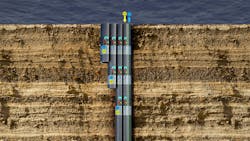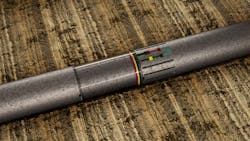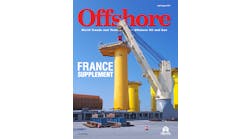Intelligent Pipe delivers real-time data for well integrity assessment
Offshore and subsea well operators have historically faced major challenges in monitoring the integrity and performance of their facilities. A pressure increase or a leakage can easily go undetected, ultimately forcing operations to be shut down to prevent a blow-out and potential loss of the well.
Allowing operators to access real-time data while monitoring the well’s performance could prevent such issues arising. Vallourec has developed ‘Intelligent Pipes’, a new way of delivering continuous, real-time well data to assess well integrity and performance. The first commercial application began earlier this year, with an existing client using the technology in a complex well installation, with production teams onboard the surface facility using the data to support safer and more efficient operations.
This is a co-development with OpenField Technology, which supplies the miniature sensors that are embedded outside of the pipes to capture and steadily stream data concerning temperature and pressure, ensuring that the pipes function correctly and maintain their structural integrity.
The data capture/retrieval system works on any size of pipe, with no positioning restrictions in terms of well depth or annulus. During well construction, the Intelligent Pipe is powered by its own battery: once the well is live, continuous power is generated by the system at its position on the tubing, connected to the surface via an electrical downhole cable. Non-magnetic pipes connect the Intelligent Pipe casing to its tubing system, enabling transmission of both power and data. The solution, which is qualified as a VAM connection, is adaptable, with a minimum length of 4 m (13 ft). Its sensors, which require only a small amount of energy for permanent well monitoring, have been optimized for shock and vibration resistance.
Well integrity is ensured by monitoring pressure and temperature of the entire wellbore in real-time, anticipating any abnormal annulus behavior. Real-time monitoring during the production start-up phase also lessens the risk of annular pressure buildup (APB): by maintaining the appropriate APB level at all times, production can be optimized without jeopardizing the well’s integrity.
The solution is configured to immediately alert the operator of potentially abnormal behavior ahead of a leak taking place. As soon as the anomaly or safety issue is detected, operations can be halted before the problem escalates. And as remedial action is taken, it becomes easier to forestall even greater potential failures that may be coming down the pipe. Anticipating the issue of the first stage will help to prevent a bigger issue on the wells. Stopping operations on time could avoid a leakage that could develop into a pipe failure if not acted on in time; or, it could avoid a pipe collapse in the event of unexpected APB.
As an option, Vallourec can offer its pipe performance database and Smartengo Running Expert digital system to provide digital well performance analysis to optimize drilling and running operations. Combining well pressure and temperature data supplied by the sensors with the actual pipe resistance and performance provided by the pipe database allows the operator to analyze whether a pipe configuration is sustainable for the well operations and loads likely to be encountered during the well lifecycle.
Formation insights
Operators can also use the real-time access to critical data concerning the environment surrounding the well for insights into the formation beyond the casing, including any geological shifts. During drilling, operators typically access equipment and sensors that provide data on the formation and reservoir. However, it may not be possible to predict how the formation will behave after the drilling phase, results of injection processes, or the impact of a depleted reservoir on geological layers.
The Intelligent Pipe sensors offer a window into what is happening beyond the casing, providing direct data access on the reservoir itself, including how each different production zone is performing. Having sensors in each zone allows pressure to be calculated in each area. During production the well might ordinarily be cut off periodically to allow logging tools to be run inside to record pressure and calculate flow. With this solution, the data monitoring process is permanent, providing a monitoring platform within the reservoir that can implement different sensing elements, including a hydrocarbon / water interface and water saturation.
Operators looking to develop key well parameters during the well’s entire lifecycle have traditionally used simulated models to monitor the well’s performance, creating theoretical well loads by inputting load information into a software application, and building in safety factors to prevent any overloads. With the Intelligent Pipe, operators gain insight into their actual well loads to achieve a truly optimized well design, rather than relying on theoretical ones. The proprietary sensors compile the well load data in real time, checking against simulations, allowing well designs to be adapted and optimized.
The temperature sensors detect channeling in cement, which allows theoretical models such as the geological thermal gradient to be adapted to actual data, even to confirm fluid insulation efficiency. Pressure is monitored in real time to optimize the APB level and production rate, and to provide alerts to any abnormal behaviors that may require operations to cease. Leakages are easily detected, ensuring that swift steps are taken to prevent well failure. The Intelligent Pipe solution can even monitor the impact of the well on the surrounding geological layer.
Together, the pressure and temperature data can indicate any issues encountered in the well, such as inside or outside leakage. Vallourec is now working on sensors that could provide data related to reservoir key parameters and fluid properties within tubing.
The system is designed to serve the entire well lifecycle, from installation through to decommissioning. It can provide data for the P&A preparation plan by giving information on well annulus integrity and permanent barrier quality for 30 years. In the future, it could be implemented in a global monitoring approach, using a platform designed for post-decommissioning monitoring.
It can also be applied for carbon capture, utilization and storage, providing information during the injection phase through sensors adapted to measure CO2 properties within the tube. A CO2 detector could be designed for the post-injection phase, although this is not part of the solution’s current capabilities.




